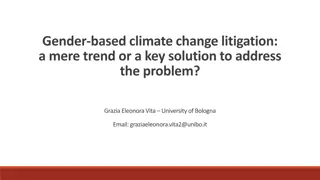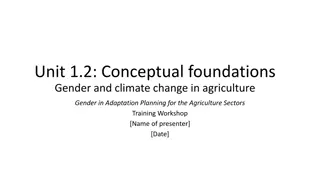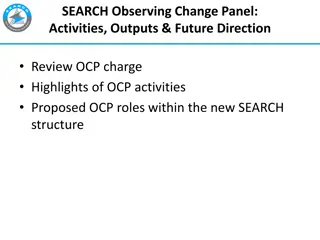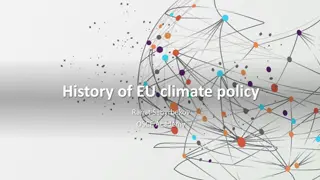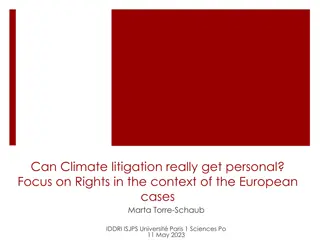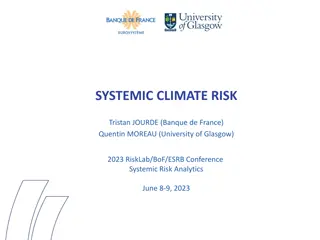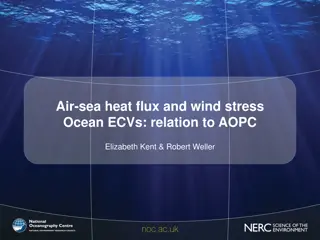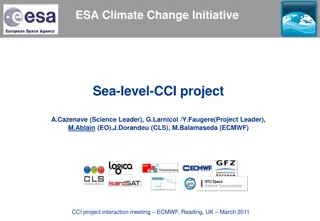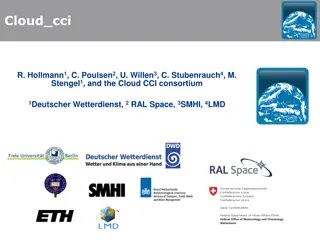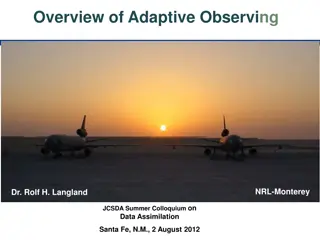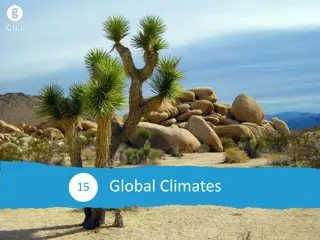Global Climate Observing System (GCOS) including GRUAN
Ozone plays a crucial role in the Global Climate Observing System (GCOS), impacting atmospheric and surface variables. Learn about GCOS recommendations, GRUAN network parameters, and essential climate monitoring principles for ozone research support.
Download Presentation

Please find below an Image/Link to download the presentation.
The content on the website is provided AS IS for your information and personal use only. It may not be sold, licensed, or shared on other websites without obtaining consent from the author.If you encounter any issues during the download, it is possible that the publisher has removed the file from their server.
You are allowed to download the files provided on this website for personal or commercial use, subject to the condition that they are used lawfully. All files are the property of their respective owners.
The content on the website is provided AS IS for your information and personal use only. It may not be sold, licensed, or shared on other websites without obtaining consent from the author.
E N D
Presentation Transcript
Global Climate Observing System (GCOS) including GRUAN Greg Bodeker Bodeker Scientific, Alexandra, New Zealand Presented at the 9th Ozone Research Managers Meeting, Geneva, 14-16 May 2014
Overview What role does ozone play in GCOS? What should the international ozone research community be doing to support the activities of GCOS and meet the needs of GCOS? GRUAN The GCOS Reference Upper Air Network What are the defining operational parameters of GRUAN? Outcomes of the 2012 GRUAN Network Expansion Workshop regarding locations for ozone monitoring.
Ozone and GCOS GCOS Essential Climate Variables (ECVs) Oceanic Atmospheric Terrestrial Surface: Air temperature, precipitation, air pressure, surface radiation budget, wind speed and direction, water vapour. Upper-air: Earth radiation budget (including solar irradiance), upper-air temperature (including MSU radiances), wind speed and direction, water vapour, cloud properties. Composition: Carbon dioxide, methane, ozone, other long- lived greenhouse gases, aerosol properties.
GCOS recommendations for producing a climate data record for an ECV There are the 20 GCOS Climate Monitoring Principles: http://www.wmo.int/pages/prog/gcos/documents/GCOS_Climate_Monitoring_Principles.pdf Of particular importance for ozone are: Impact of new systems or changes to existing systems should be assessed prior to implementation e.g. change in absorption cross-sections. Importance of collecting and archiving meta data. Quality and homogeneity of data should be regularly assessed. Operation of historically-uninterrupted stations and observing systems should be maintained. Good geographical coverage especially in regions where changes are occurring or are expected to occur e.g. the tropics now for ozone. A suitable period of overlap for new and old satellite systems should be ensured for a period adequate to determine inter- satellite biases.
GCOS guidelines for the generation of data sets and products (GCOS-143) Full description of all steps taken in construction of CDR. Application of appropriate calibration/validation. Statement of expected accuracy, stability and resolution. Assessment of long-term stability and homogeneity of the product. Scientific review process related to product construction. Global coverage of CDR where possible. Version management of CDRs, particularly in connection with improved algorithms and periodic reprocessing. Access to CDR including all inputs and documentation. Timeliness of data release to the user community Facility for user feedback Application of a quantitative maturity index if possible Publication in international peer-reviewed journal.
What is GRUAN? GCOS Reference Upper Air Network Network for ground-based reference observations for climate in the free atmosphere in the frame of GCOS Currently ~15 stations, envisaged to be a network of 30-40 sites across the globe
GRUAN Governance UNEP IOC ICSU WMO GCOS SC WCRP CIMO/CBS/CAS/CCL Guidance on research requirements Guidance on operational requirements AOPC WG-GRUAN Reporting Guidance Task and analysis teams Measurement sites Lead Center See www.gruan.org for further information
The goals of GRUAN The purpose of GRUAN is to: Provide long-term high quality climate records; Constrain and calibrate data from more spatially-comprehensive global observing systems (including satellites and current radiosonde networks); and Fully characterize the properties of the atmospheric column. Four key user groups of GRUAN data products are identified: The climate detection and attribution community. The satellite community. The atmospheric process studies community. The numerical weather prediction (NWP) community.
More about goals of GRUAN Priority 1: Temperature, pressure, water vapour Priority 2: Ozone, methane Multi-decade measurement programmes. Characterize observational biases. Robust, traceable estimates of measurement uncertainty. Ensure traceability through comprehensive meta-data collection and documentation. Ensure long-term stability by managing measurement system changes. Tie measurements to SI units or internationally accepted standards. Measure a large suite of co-related climate variables with deliberate measurement redundancy
Definition of a Reference Observation A GRUAN reference observation: Is traceable to an SI unit or an accepted standard Provides a comprehensive uncertainty analysis Maintains all raw data Includes complete meta data description Is documented in accessible literature Is validated (e.g. by intercomparison or redundant observations)
Uncertainty, redundancy and consistency Understand the uncertainties: Describe/Analyze sources - identify, which sources of measurement uncertainty are systematic (calibration, radiation errors), and which are random (noise, production variability ). Document this. Quantify/Synthesize best uncertainty estimate: Uncertainties for every data point, i.e. vertically resolved Use redundant observations to verify that the evaluated net uncertainty is in agreement with the required target uncertainty. Also use redundant observations to: to manage change to maintain homogeneity of observations across network to continuously identify deficiencies
Establishing reference quality Uncertainty of input data Traceable sensor calibration Transparent processing algorithm GRUAN measurement Best estimate and uncertainty X X X Black box software Proprietary methods Disregarded systematic effects
GRUAN Network Expansion workshop 13-15 June 2012 in F rstenwalde. Define the scientific basis to guide the expansion of GRUAN from its then 15 sites (Ny lesund now added), to the expected 35-40 over the next few years. The emphasis was on defining the criteria by which network expansion should occur and to consider prospective sites. Little or no consideration given to what they should measure or how they should measure it. Bring the workshop White Papers to a nearly completed state. Entrain additional expertise into GRUAN. Use quantitative & objective approach to determine how to augment the current GRUAN network with additional sites and to provide recommendations for new sites identified during the workshop & in the resultant White Papers.
An example of quantitative analysis The number of years of measurements required to detect a trend at the 95% confidence level with a probability of 0.9 can be approximated by (Whiteman et al., 2011): where N is the standard deviation of the total noise in the time series, i.e. the standard deviation of the residuals after the application of the trend regression model, 0 is the trend magnitude, and N is the autocorrelation of the noise. Consider how this applies to total column ozone
21st century trends in total column ozone Calculated from the median values of 21 chemistry- climate models
Standard deviation of the monthly means Calculated from the Bodeker Scientific global total column ozone database: 1978-2012
First order autocorrelation coefficient Calculated from the Bodeker Scientific global total column ozone database: 1978-2012
Optimal location Ushuaia
Conclusions GRUAN is a new approach to long term observations of upper air essential climate variables Focus on reference observation: quantified uncertainties traceable well documented Understand the uncertainties: analyze sources synthesize best estimate verify in redundant observations Objective criteria can be used to optimize the location for detecting expected trends in total column ozone but this is of course not the only criterion for where to locate sites.
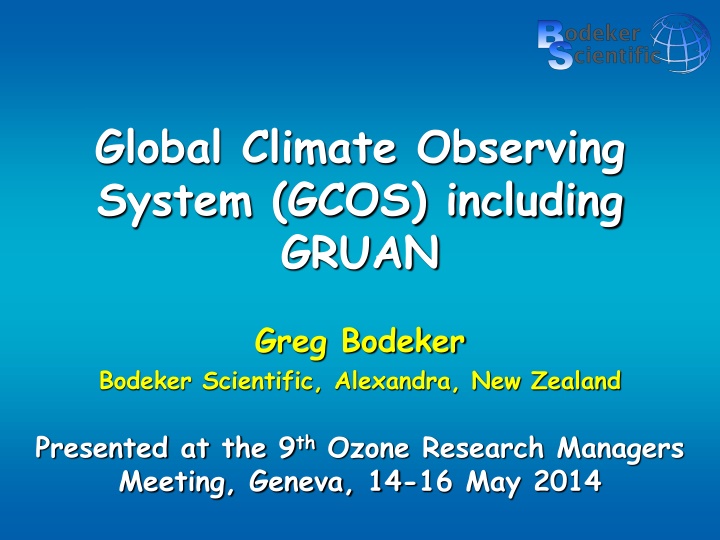

![[PDF⚡READ❤ONLINE] Solar Surveyors: Observing the Sun from Space (Springer Praxis](/thumb/21536/pdf-read-online-solar-surveyors-observing-the-sun-from-space-springer-praxis.jpg)








